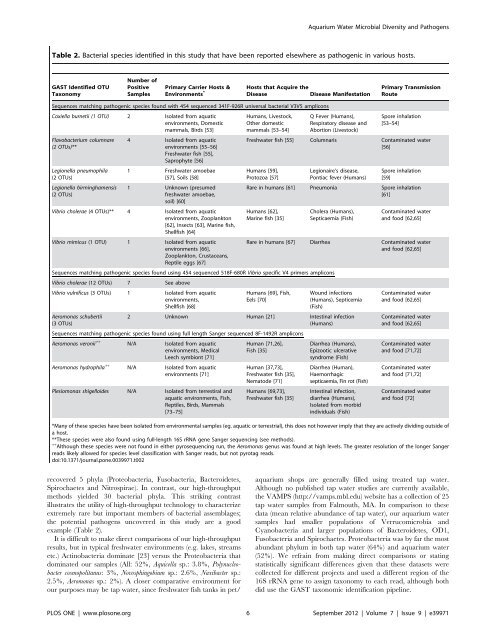Microbial Diversity and Potential Pathogens in Ornamental Fish ...
Microbial Diversity and Potential Pathogens in Ornamental Fish ...
Microbial Diversity and Potential Pathogens in Ornamental Fish ...
You also want an ePaper? Increase the reach of your titles
YUMPU automatically turns print PDFs into web optimized ePapers that Google loves.
Table 2. Bacterial species identified <strong>in</strong> this study that have been reported elsewhere as pathogenic <strong>in</strong> various hosts.<br />
GAST Identified OTU<br />
Taxonomy<br />
Number of<br />
Positive<br />
Samples<br />
Primary Carrier Hosts &<br />
Environments *<br />
recovered 5 phyla (Proteobacteria, Fusobacteria, Bacteroidetes,<br />
Spirochaetes <strong>and</strong> Nitrospirae). In contrast, our high-throughput<br />
methods yielded 30 bacterial phyla. This strik<strong>in</strong>g contrast<br />
illustrates the utility of high-throughput technology to characterize<br />
extremely rare but important members of bacterial assemblages;<br />
the potential pathogens uncovered <strong>in</strong> this study are a good<br />
example (Table 2).<br />
It is difficult to make direct comparisons of our high-throughput<br />
results, but <strong>in</strong> typical freshwater environments (e.g. lakes, streams<br />
etc.) Act<strong>in</strong>obacteria dom<strong>in</strong>ate [23] versus the Proteobacteria that<br />
dom<strong>in</strong>ated our samples (All: 52%, Aquicella sp.: 3.8%, Polynucleobacter<br />
cosmopolitanus: 3%, Novosph<strong>in</strong>gobium sp.: 2.6%, Naxibacter sp.:<br />
2.5%, Aeromonas sp.: 2%). A closer comparative environment for<br />
our purposes may be tap water, s<strong>in</strong>ce freshwater fish tanks <strong>in</strong> pet/<br />
Hosts that Acquire the<br />
Disease Disease Manifestation<br />
Sequences match<strong>in</strong>g pathogenic species found with 454 sequenced 341F-926R universal bacterial V3V5 amplicons<br />
Coxiella burnetii (1 OTU) 2 Isolated from aquatic<br />
environments, Domestic<br />
mammals, Birds [53]<br />
Flavobacterium columnare<br />
(2 OTUs)**<br />
Legionella pneumophila<br />
(2 OTUs)<br />
Legionella birm<strong>in</strong>ghamensis<br />
(2 OTUs)<br />
4 Isolated from aquatic<br />
environments [55–56]<br />
Freshwater fish [55],<br />
Saprophyte [56]<br />
1 Freshwater amoebae<br />
[57], Soils [58]<br />
1 Unknown (presumed<br />
freshwater amoebae,<br />
soil) [60]<br />
Vibrio cholerae (4 OTUs)** 4 Isolated from aquatic<br />
environments, Zooplankton<br />
[62], Insects [63], Mar<strong>in</strong>e fish,<br />
Shellfish [64]<br />
Vibrio mimicus (1 OTU) 1 Isolated from aquatic<br />
environments [66],<br />
Zooplankton, Crustaceans,<br />
Reptile eggs [67]<br />
Humans, Livestock,<br />
Other domestic<br />
mammals [53–54]<br />
Q Fever (Humans),<br />
Respiratory disease <strong>and</strong><br />
Abortion (Livestock)<br />
Primary Transmission<br />
Route<br />
Spore <strong>in</strong>halation<br />
[53–54]<br />
Freshwater fish [55] Columnaris Contam<strong>in</strong>ated water<br />
[56]<br />
Humans [59],<br />
Protozoa [57]<br />
Legionaire’s disease,<br />
Pontiac fever (Humans)<br />
Spore <strong>in</strong>halation<br />
[59]<br />
Rare <strong>in</strong> humans [61] Pneumonia Spore <strong>in</strong>halation<br />
[61]<br />
Humans [62],<br />
Mar<strong>in</strong>e fish [35]<br />
Cholera (Humans),<br />
Septicaemia (<strong>Fish</strong>)<br />
Contam<strong>in</strong>ated water<br />
<strong>and</strong> food [62,65]<br />
Rare <strong>in</strong> humans [67] Diarrhea Contam<strong>in</strong>ated water<br />
<strong>and</strong> food [62,65]<br />
Sequences match<strong>in</strong>g pathogenic species found us<strong>in</strong>g 454 sequenced 518F-680R Vibrio specific V4 primers amplicons<br />
Vibrio cholerae (12 OTUs) 7 See above<br />
Vibrio vulnificus (3 OTUs) 1 Isolated from aquatic<br />
Humans [69], <strong>Fish</strong>, Wound <strong>in</strong>fections<br />
environments,<br />
Eels [70]<br />
(Humans), Septicemia<br />
Shellfish [68]<br />
(<strong>Fish</strong>)<br />
Aeromonas schubertii 2 Unknown Human [21] Intest<strong>in</strong>al <strong>in</strong>fection<br />
(3 OTUs)<br />
(Humans)<br />
Sequences match<strong>in</strong>g pathogenic species found us<strong>in</strong>g full length Sanger sequenced 8F-1492R amplicons<br />
Aeromonas veronii ++<br />
N/A Isolated from aquatic<br />
Human [71,26], Diarrhea (Humans),<br />
environments, Medical <strong>Fish</strong> [35]<br />
Epizootic ulcerative<br />
Leech symbiont [71]<br />
syndrome (<strong>Fish</strong>)<br />
Aeromonas hydrophila ++<br />
N/A Isolated from aquatic<br />
Human [37,73], Diarrhea (Human),<br />
environments [71]<br />
Freshwater fish [35], Haemorrhagic<br />
Nematode [71] septicaemia, F<strong>in</strong> rot (<strong>Fish</strong>)<br />
Plesiomonas shigelloides N/A Isolated from terrestiral <strong>and</strong> Humans [69,73], Intest<strong>in</strong>al <strong>in</strong>fection,<br />
aquatic environments, <strong>Fish</strong>, Freshwater fish [35] diarrhea (Humans),<br />
Reptiles, Birds, Mammals<br />
Isolated from morbid<br />
[73–75]<br />
<strong>in</strong>dividuals (<strong>Fish</strong>)<br />
Aquarium Water <strong>Microbial</strong> <strong>Diversity</strong> <strong>and</strong> <strong>Pathogens</strong><br />
Contam<strong>in</strong>ated water<br />
<strong>and</strong> food [62,65]<br />
Contam<strong>in</strong>ated water<br />
<strong>and</strong> food [62,65]<br />
Contam<strong>in</strong>ated water<br />
<strong>and</strong> food [71,72]<br />
Contam<strong>in</strong>ated water<br />
<strong>and</strong> food [71,72]<br />
Contam<strong>in</strong>ated water<br />
<strong>and</strong> food [72]<br />
*Many of these species have been isolated from environmental samples (eg. aquatic or terrestrial), this does not however imply that they are actively divid<strong>in</strong>g outside of<br />
a host.<br />
**These species were also found us<strong>in</strong>g full-length 16S rRNA gene Sanger sequenc<strong>in</strong>g (see methods).<br />
++ Although these species were not found <strong>in</strong> either pyrosequenc<strong>in</strong>g run, the Aeromonas genus was found at high levels. The greater resolution of the longer Sanger<br />
reads likely allowed for species level classification with Sanger reads, but not pyrotag reads.<br />
doi:10.1371/journal.pone.0039971.t002<br />
aquarium shops are generally filled us<strong>in</strong>g treated tap water.<br />
Although no published tap water studies are currently available,<br />
the VAMPS (http://vamps.mbl.edu) website has a collection of 25<br />
tap water samples from Falmouth, MA. In comparison to these<br />
data (mean relative abundance of tap water), our aquarium water<br />
samples had smaller populations of Verrucomicrobia <strong>and</strong><br />
Cyanobacteria <strong>and</strong> larger populations of Bacteroidetes, OD1,<br />
Fusobacteria <strong>and</strong> Spirochaetes. Proteobacteria was by far the most<br />
abundant phylum <strong>in</strong> both tap water (64%) <strong>and</strong> aquarium water<br />
(52%). We refra<strong>in</strong> from mak<strong>in</strong>g direct comparisons or stat<strong>in</strong>g<br />
statistically significant differences given that these datasets were<br />
collected for different projects <strong>and</strong> used a different region of the<br />
16S rRNA gene to assign taxonomy to each read, although both<br />
did use the GAST taxonomic identification pipel<strong>in</strong>e.<br />
PLOS ONE | www.plosone.org 6 September 2012 | Volume 7 | Issue 9 | e39971
















